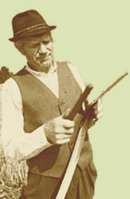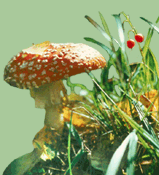Bats are protected species in Estonia
Triinu Tõrv gives a thorough and captivating overview of the species diversity of our bats, their ways of life and protection needs. In Estonia, there are records of 12 bat species, which differ largely based on their habitat requirements and ways of life. Some of the species are local, some of them migrate. However, bats are difficult to study and therefore we still dont know much about their numerousness or migration habits. The article sheds some light to the facts we do know, and how the species differ from each other. Numerous close-up photographs and a figure help to learn to differentiate between different species.
Estonian Nature enquires
Lauri Valdur, a hunter, writes about the joy Bloodless Hunt brings to hunters.
On heritage culture, dedicated to the year of cultural heritage in 2013
Lembitu Tarang, Triin Kusmin and Jürgen Kusmin discuss the signs of past human activities in landscape, and elaborate on the meaning of these signs in current world. Typical objects of cultural heritage include old farmsteads, place names, forest keeper sites, windmills, schoolhouses, manor houses, soviet heritage and new settlements of 1920ies. Several studies and inventories have already been carried out, but a lot more is still to be done.
The first experiences of Estonians with burning stone
Erki Tammiksaar and Taavi Pae take a glance at the forgotten moments of oil shale history. Although it was long thought that oil shale was discovered by Estonians and that people know about oil shale a long time, it appears not to be true. Estonians learned about the burning qualities of oil shale while digging drainage ditches oil shale was brought to the ground, and it caught fire very easily. However, in the beginning of the 20th century the knowledge about oil shale remained very modest among local Estonians. The authors also introduce the first Estonian oil shale researcher, Wilhelm Johanson, who has been left out of the official history of oil shale mining in Estonia.
Apples, juice, cider and calvados
Urmas Kokassaar describes the phases of producing calvados in France: first comes juice, then cider, the brandy calvados. Cider is produced from different varieties of apples, often inedible, and let stand until the alcohol content reaches 45%. The content of alcohol in calvados is always 70%, and it is left to age in oak casks.
Interview: Estonian culture is strong
Juhan Javoið has interviewed Marju Kõivupuu, a folklorist.
The 75th birthday of the Lipstu heath protected area
Tiit Petersoo reminds the story of of a protected alvar area at Raplamaa, and introduces the natural values of the alvar. Although called a heath, it is not actually a heath, but an alvar. It was the first alvar forest to be taken under protection in Estonia. The author looks at the history of naming it a protected area.
Estonian stoutest apple trees
Hendrik Relve sums up the field work of last summer: most old trees protected as wild apple trees are in fact domestic apple trees gone wild. There are five apple trees listed as protected natural monuments in Estonia, and only one of them, growing at Pilguse, Saaremaa Island, is most probably a wild apple tree. The stoutest apple tree is the Oti apple tree in the village of Oti, Viljandi County. However, there might be some trees that are even stouter that we do not know about.
Deathwatch beetles on apple trees
Kaljo Voolma introduces the species of deathwatch beetles that can be met in gardens, and some of these are listed as endangered species in the Red List. There are 5 species of deathwatch beetles which inhabit apple trees in Estonia: three species of genus Scolytus, and two species of genus Xyleborus. A species of the genus Scolytus Scolytus mali is an endangered species in Sweden and in Estonia. The species is no threat to young orchards, as it inhabits old orchards.
The secret of the word õunapuu (apple tree)
Karl Pajusalu looks into the genesis of words õunapuu and ubin (apple tree), which lead the way back to Kazakhstan, the first home of apple trees. In most European languages, the name apple tree is quite alike and is derived from the name for the fruit apple. However, it is quite difficult to explain the evolution of the name uibu, the south-estonian language name for apple tree.
Apple tree in the yard
Tõnu Ploompuu writes an essay about the importance of an age-old apple tree for himself, the owner as well as for the fauna of the surroundings.
|


![[IN ENGLISH]](images/gb.gif)





